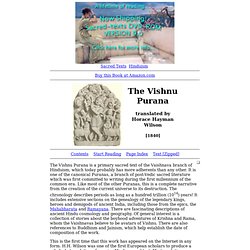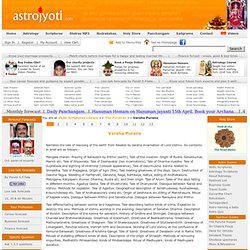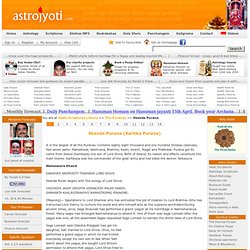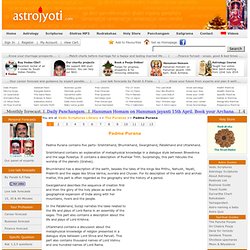

Shiv Mahapuran. Shiva Purana (English) VayuPurana1.36oncosmogonyEng.Tagare. The Vishnu Purana Index. Sacred Texts Hinduism Buy this Book at Amazon.com Contents Start Reading Page Index Text [Zipped] The Vishnu Purana is a primary sacred text of the Vaishnava branch of Hinduism, which today probably has more adherents than any other.

The Garuda Purana Index. Contents Start Reading Page Index Text [Zipped] This is a translation of an abridged version of the Garuda Purana.

The Garuda Purana is one of the Vishnu Puranas. It is in the form of a dialog between Vishnu and Garuda, the King of Birds. The second section of this Purana (given here) deals with issues connected with death, particularly funeral rites and the metaphysics of reincarnation. Varaha Purana. Narrates the tale of rescuing of the earth from Rasatal by Varaha incarnation of Lord Vishnu.

Its contents in brief are as follows:- Mangala charan: Praying of Narayana by Prithvi (earth). Skanda Purana or Kartika Purana. It is the largest of all the Puranas.

Contains eighty eight thousand and one hundred Shlokas (stanzas). Has seven parts- Maheshwar, Vaishnava, Brahma, Kashi, Avanti, Nagar and Prabhasa. Purana got its name from Skand (Kartikeya) the son of Lord Shiva. Birth of Skand; its reason and effects constitute the main theme. Kartikeya was the commander of the gods’ army and had killed the demon Tarkasura. Maheswara Khand Skanda Puran begins with the eulogy of Lord Shiva– (Meaning)— Salutations to Lord Shankar who has entrusted the job of creation to Lord Brahma–Who has instructed Lord Vishnu to nurture the world and who himself acts as the supreme annihilator.During ancient times, once, Sage Shaunak had performed a grand ‘yagya’ at his hermitage in Naimisharanya forest. Sage Lomesh said–Daksha-Prajapati had got his daughter, Sati married to Lord Shiva.
When Sati reached her father’s place, she saw a grand yagya being performed. When Daksha saw Sati, he was enraged—How dare you come here? Padma Purana. Padma Purana contains five parts- Srishtikhand, Bhumikhand, Swargkhand, Patalkhand and Uttarkhand.

Srishtikhand contains an explanation of metaphysical knowledge in a dialogue style between Bheeshma and the sage Pulastya. It contains a description of Pushkar Tirth. Narada Purana. Suta and the Other sages Narayanam namaskritya naranchaiva narottaman devim sarasvatinchaiva tato jayamudirayet.

This is always the first shloka in any Purana. Narayana is another name for Vishnu. The couplet means that, prior to reading the sacred texts, one should pray to Narayana and Nara, the best of all humans. One should also pray to Sarasvati, the goddess of learning. It is only after these prayers are over that one can start reading the sacred texts known as jaya. There was a forest known as naimisharanya. The sages were trying to attain the four goals of dharma (righteousness), artha (that which gives meaning to life).
When the sages were busy discussing and debting, the sage Shounaka said, “I would like to submit something for the consideration of the assembly. The other sages were delighted at this wonderful suggestion. Suta was engaged in performing a yajna then. Linga Purana. Suta and Other Sages We first pray to Brhama, the creator; Vishnu, the preserver; and Shiva, the destroyer.

We also pray to the sages Nara and Narayana and Sarasvati, the goddess of learning. Our prayers are due to the sage Vedavyasa. It is only after these prayers that we can begin to read the sacred texts. A tirtha is a place of pilgrimage. Kurma Purana. Lord Vishnu, in Kurm Avatar (tortoise incarnation), had first preached this Purana to Narad.

In his turn, Narad narrated it to Sutji who later narrated this Purana to an assembly of the great sages. Initially, this Purana had four parts namely Bramhi Samhita, Bhagawati Samhita, Gauri Samhita and Vaishnavi Samhita. Presently, however, none of these Samhitas is available except Brahm Samhita. Present version too contains two parts-Purv and Uttar Parts. Purv Part: Tale of Indradyumna. Uttar Part: Yoga of unexpressed knowledge. Brahma Vaivarta Purana. It’s the twelth Purana.

It contains four parts- Brahma khand, Prakriti khand, Ganesh khand and Shri Krishna Janma khand. In Naimisharanya Tirth, addressing a gathering of great sages like Shaunak etc., Sutaji has described this Purana as the marvelous creation. Brahma Purana. In the forest known as naimisharanya.

The sages (maharshis) arranged for a sacrifice (yajna) in this forest and the ceremony went on for twelve years. Naimisharanya forest was a wonderful place to arange sacrifices in. Bhavishya Purana. The Bhavishya Purana is the eleventh among the Puranas and it contains five parts. The first part contains a description of the genesis, greatness of the deities and worship of Lord Vishnu, Shiva and Surya. Second, third and fourth parts describe about the greatness of Shiva, Vishnu and Surya respectively. Agni Purana. The Agni Purana is a mahapurana. It usually figures eighth in the list of eighteen. There are about fifteen and a half thousand shlokas in the Agni Purana. The Agni Purana is a tamasika purana. The others in this group are the Matsya, Kurma Linga, Shiva and Skanda Puranas.
Vamana Purana. Narada asks sage Pulastya about Vaamana incarnation: Vaaman Puraan is one of the eighteen Puraans written by sage Vyasa. It contains tales pertaining to Lord Vishnu in his Vaaman (dwarf) incarnation. Sage Pulastya while giving answers to Narad’s enquiry narrates the tale of Vaaman Puraan. All the Puraans give glimpses of Indian civilization and culture and Vaaman Puraan is no exception. Matsya Purana complete. Introduction Thre are eighteen major Puranas or mahapuranas, the word maha, meaning great. There are also several other minor Puranas or upapuranas, the word upa signifying minor. Amongst the eighteen mahapuranas, the Matsya Purana is number sixteen. The Puranas themselves describes the five characteristics (pancha lakshana) that a text must satisfy before being classified as a mahapurana.